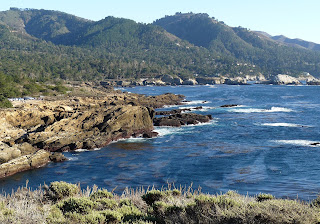The
jewel in the crown of California's State Park system - Point Lobos is
famous for its breathtaking two mile coastline that offers to the visitor
views of beautiful coves and mysterious caves, an abundance of spring wildflowers,
nesting birds on offshore rocks, otters and seals, and dramatic Cypress trees precariously perched on
rugged rock formations. Point Lobos is a nature lovers paradise.
A United States Natural Landmark, Point Lobos is located about three miles south of Carmel on Highway One. Hours are 8 to a 1/2 hour after sunset, fee $10, seniors $9. A map with in-depth information on the reserve and the trails is available at the entrance kiosk for $2. Trail maps can also be found at http://pointlobos.org/planning-your-visit/trail-maps
After you enter the reserve, the first road on your right takes you to Whaler's Cove and Whalers Cabin Museum (above). The Museum holds a wealth of historic information. The abalone diver (below) is one of the fascinating artifacts found in the Cabin Museum which is staffed with friendly and informative docents.
The parking/picnic area, left side of photo, down the slight hill from the cabin, was the location the "Point Lobos Canning Co." where abalone was canned from 1899 - 1928. (photo - Whale's Cove and distant Carmel Cove)
Whaler's Cove is extremely popular with divers.
The offshore waters are one of the richest underwater habitats in the world. Scuba and free diving is by permit only - for reservations go to http://www.parks.ca.gov/?page_id=28353
The parking/picnic area, left side of photo, down the slight hill from the cabin, was the location the "Point Lobos Canning Co." where abalone was canned from 1899 - 1928. (photo - Whale's Cove and distant Carmel Cove)
Whaler's Cove is extremely popular with divers.
The offshore waters are one of the richest underwater habitats in the world. Scuba and free diving is by permit only - for reservations go to http://www.parks.ca.gov/?page_id=28353
Straight
ahead from the entrance kiosk (.5mi.) is the Information Station (below) and
parking area for five trails, South Shore, Sand Hill, Sea Lion Point,
Cypress Grove, and North Shore.
All but three of the 15 trails in the reserve are less than a mile. The North Shore Trail is the longest at 1.4 miles one way; it is suggested for the more agile walker; a few trails are totally accessible. Every trail leads to a scenic view. (below - view from Sea Lion Pt. Trail)
Bird Island Trail (below), one of the premier trails in the reserve, is totally accessible. Views from the trail include secluded coves, spring wildflowers, and bird rock which in the spring hosts thousands of nesting birds such as Brant Cormorant, American Oystercatcher, Black-crowned Night Heron, Black Oystercatcher, and Western Gull.
All but three of the 15 trails in the reserve are less than a mile. The North Shore Trail is the longest at 1.4 miles one way; it is suggested for the more agile walker; a few trails are totally accessible. Every trail leads to a scenic view. (below - view from Sea Lion Pt. Trail)
Bird Island Trail (below), one of the premier trails in the reserve, is totally accessible. Views from the trail include secluded coves, spring wildflowers, and bird rock which in the spring hosts thousands of nesting birds such as Brant Cormorant, American Oystercatcher, Black-crowned Night Heron, Black Oystercatcher, and Western Gull.
The above photo of Bird Island which, in the springs is dense with nesting bids, was taken from the Bird Island Trail. The trail is fully accessible, round trip, 1.4 miles.
Whale watching - Gray Whale - 40-50 ft. - 34-40 tons. In December Gray Whales begin their migration to Mexico; their return trip begins in February. Viewing is best when they head north, as the mother and calf hug the coast to avoid the killer whale. Humpback Whale - 40-52 ft. - 30-50 tons - summer through fall. Blue Whale - 75 - 80 ft - 110 tons. Occasionally from July through Sept.
Point Lobos offers drama, beauty, solitude, and peace and is the Jewel in the State Parks Crown.
Whale watching - Gray Whale - 40-50 ft. - 34-40 tons. In December Gray Whales begin their migration to Mexico; their return trip begins in February. Viewing is best when they head north, as the mother and calf hug the coast to avoid the killer whale. Humpback Whale - 40-52 ft. - 30-50 tons - summer through fall. Blue Whale - 75 - 80 ft - 110 tons. Occasionally from July through Sept.
Point Lobos offers drama, beauty, solitude, and peace and is the Jewel in the State Parks Crown.












